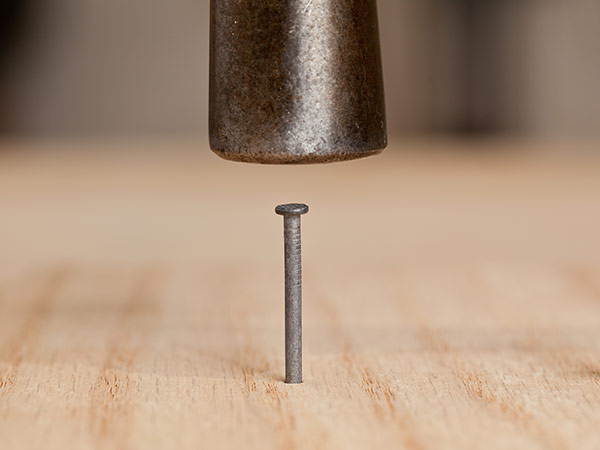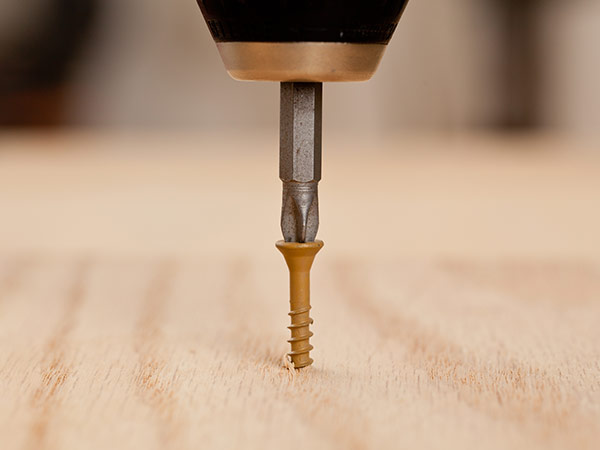

Holding Tight: Nails vs. Screws
While you might rummage blindly through your junk drawer for any old nail or screw to hang a picture frame, the two types of fasteners are not interchangeable. When it comes to large construction projects, you wouldn’t settle for “whatever’s at hand” to install drywall or even build a table. Consider the needs of your specific project, and select the right size, shape, and style of fastener for the job.


The Difference Between Nails vs. Screws
Don’t be overwhelmed by the sheer variety of sizes, shapes, and even colors of nails and screws in the fastener section of the hardware store. Fasteners like nails or screws all have specific uses and are designed for different project needs.

The main difference between screws vs nails is their uses. Nails are known for their strength and ease in installation with automated tools like a nail gun. They are typically chosen for large construction projects, like framing the walls of a house, or installing subflooring. Screws, however, also have their place, as they can create tight bonds and are ideal for mounting trim or working with delicate materials like plaster and drywall.
Parts of a Nail or Screw
- Head Types: Depending on the tool you’re using for installation or application, a certain fastener head type may be preferable. While most nails only have flat heads, you could choose a thin “finishing nail” for projects where you need a clean final product. Screws, and your screwdriver, have heads or "drive types" such as a flat-head (line-shaped), Phillips’ head (X-shaped), or a type of hex-key (square, 5-sided, star, or other shape).
- Sizes: An almost infinite variety of sizes exist, but it is best to choose longer fasteners for heavy-duty projects (such as framing a house) and small fasteners for delicate projects, like hanging a picture frame.
- Shank: The “shank” is the area between the head and the point. Some are smooth. Some are unique like spiral shank nails. It’s a nail with a spiral or ring shape that connects more tightly to hardwood applications. Masonry nails have a fluted shank that grab best to concrete block and similar materials.

- Thread: Screws have external threads (think corkscrew shapes), while nails are straight. The threads on a screw grip where inserted and make it easy to reverse to remove the fastener, if needed. On packaging, you will see thread size indicated as #8 or #10, for example, which shows the diameter of the screw. If a second number is provided, such as #8-32 on a machine screw, it indicates the number of threads per inch.
- Points: There are a large variety of points to consider, but they come in different styles depending on your project. Nails always have points, and most screws do as well. Look for different types of screw points, depending on your materials, as some work better for wood vs. metal applications. For example, self-tapping screws with a very sharp point can help you insert a screw into a particularly difficult to cut into material, like metal, or some wood or plastic materials.
- Coatings: The coatings on nails and screws can best help protect your project from decay. Stainless steel (what most fasteners are made of) resists corrosion. Other coatings such as zinc can protect fasteners in wet environments, while ceramic coatings can be ideal for construction near salt water.
How to Hold Your Project Together
Your nails may provide your project’s needed sheer strength, keeping two boards from sliding apart. Screws, by comparison, provide grip strength, and can resist pressure that pushes and pulls two materials. Decking, where vertical pressure comes from someone walking above, is best secured by screws. By contrast, the joists holding the decking in place are best held together with nails to prevent movement from side-to-side pressure. This isn’t to say you can’t use nails to make a deck, or screws to attach joists — it’s just one consideration.
How Do You Plan to Install the Fasteners?
Power tools have come a long way, and we no longer need to use a single hammer to insert a nail. You can utilize a nail gun to quickly insert nails for a large project. You can also use electric screwdrivers to insert screws. It’s much easier to reverse a screwdriver and remove a screw, whereas prying up a nail still requires a bit of precise torque, probably from a hammer and a strong arm. Always make sure to choose the right driver head to fit your screws on a project, to avoid “stripping” the head, and rendering it useless.
Your Finished Project
Finally, think about your finished product when choosing nails vs. screws. Many nails are mostly invisible when applied correctly. Their flat heads can disappear into a floor or table. Finishing nails can be placed slightly below a surface and spackled over and painted to hide their very existence. Screw heads, however, are typically very visible, and aren’t usually desired to be seen in a project’s final presentation.
Pick Up Your Fasteners and More at McCoy's
Don’t worry if you still have questions on which fastener type is right for your needs. Come by your local McCoy’s and our experts can guide you every step of the way.

